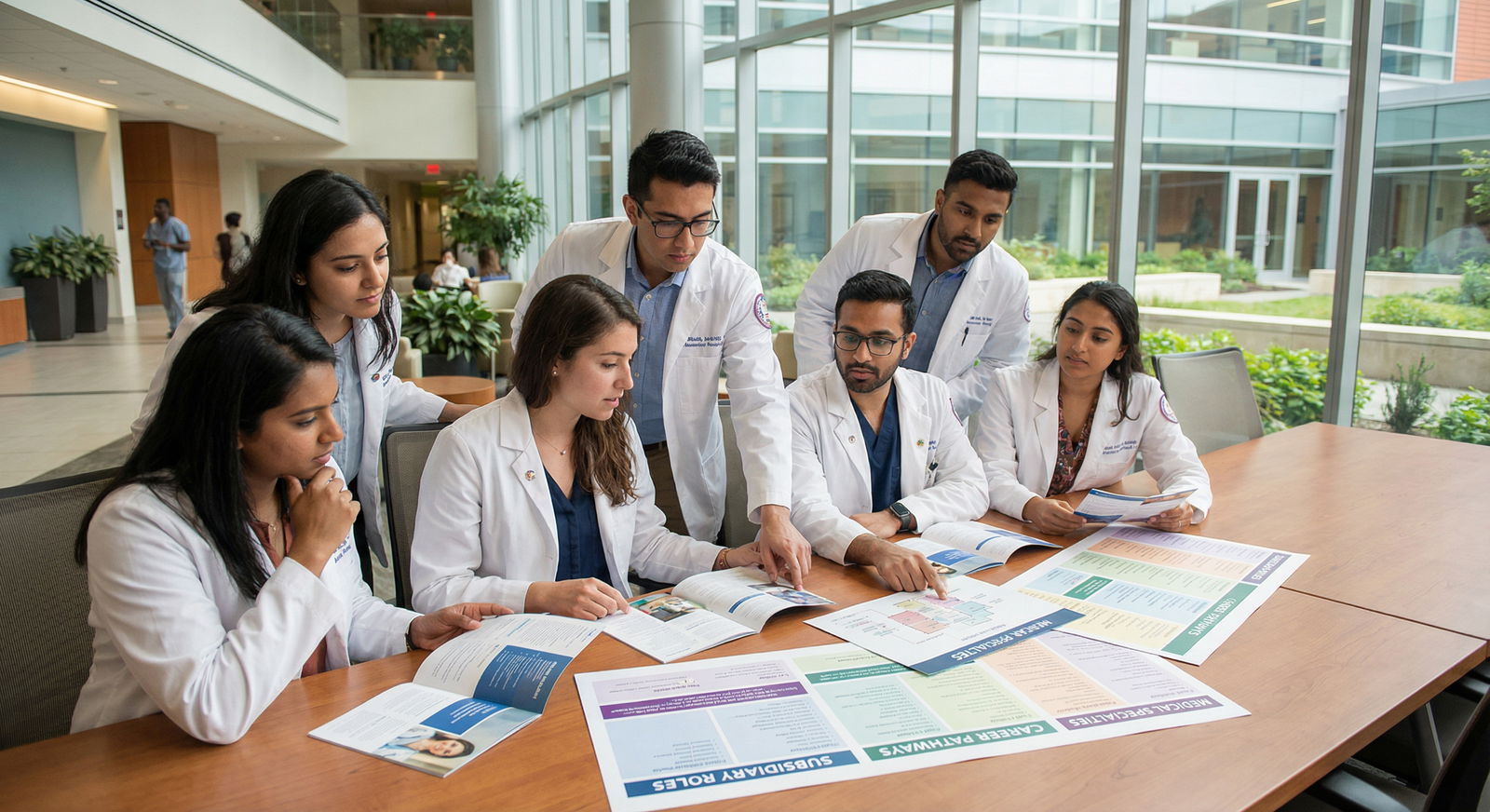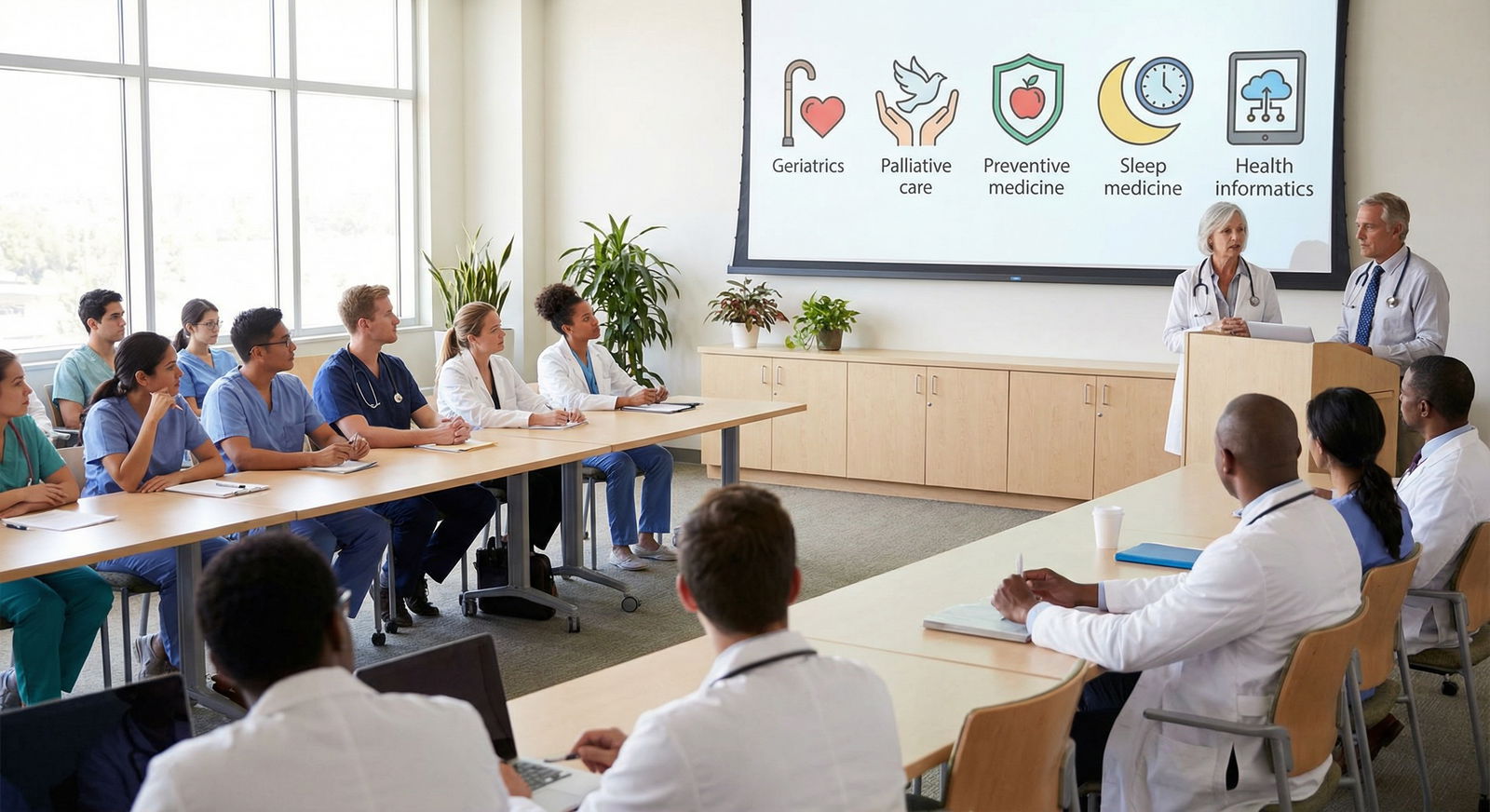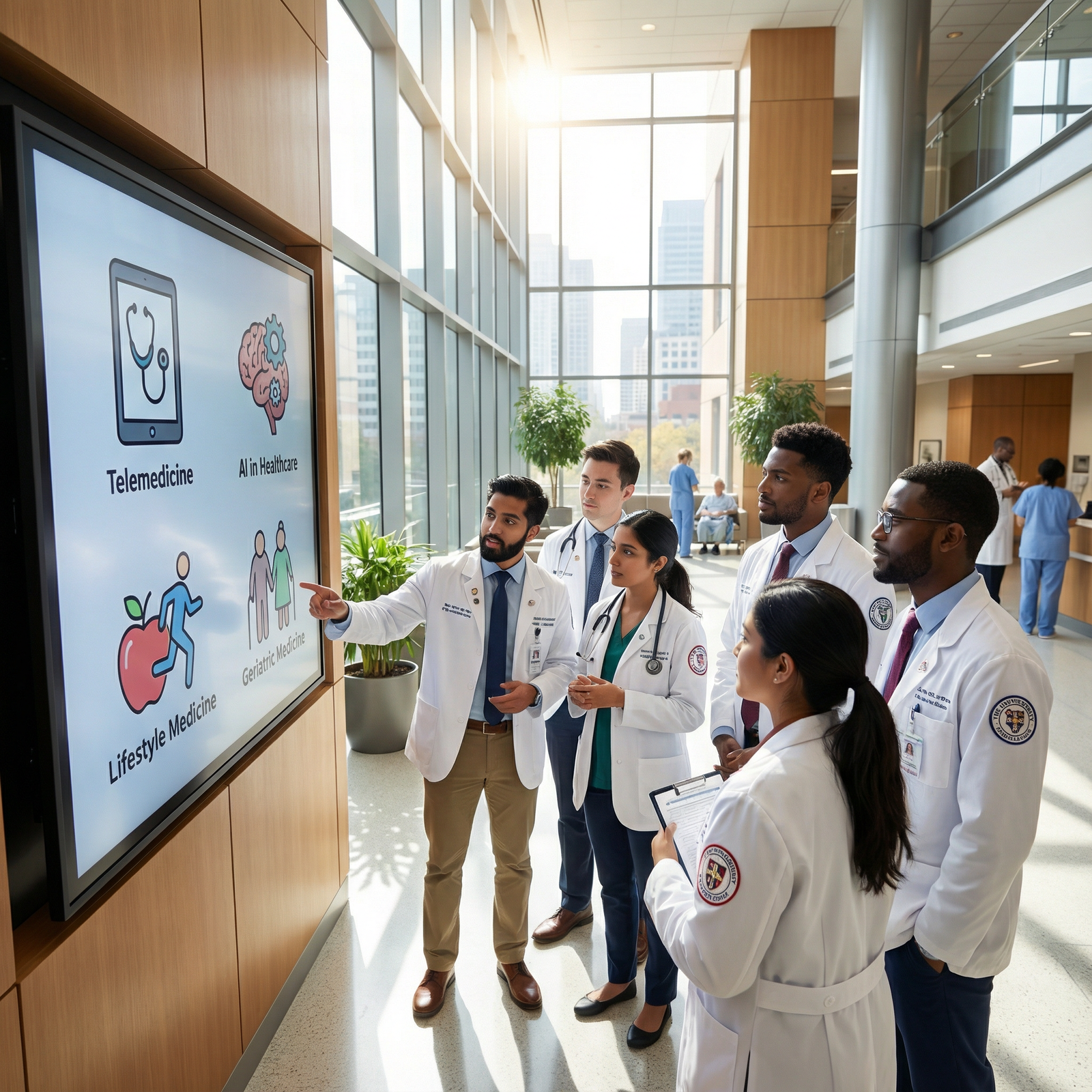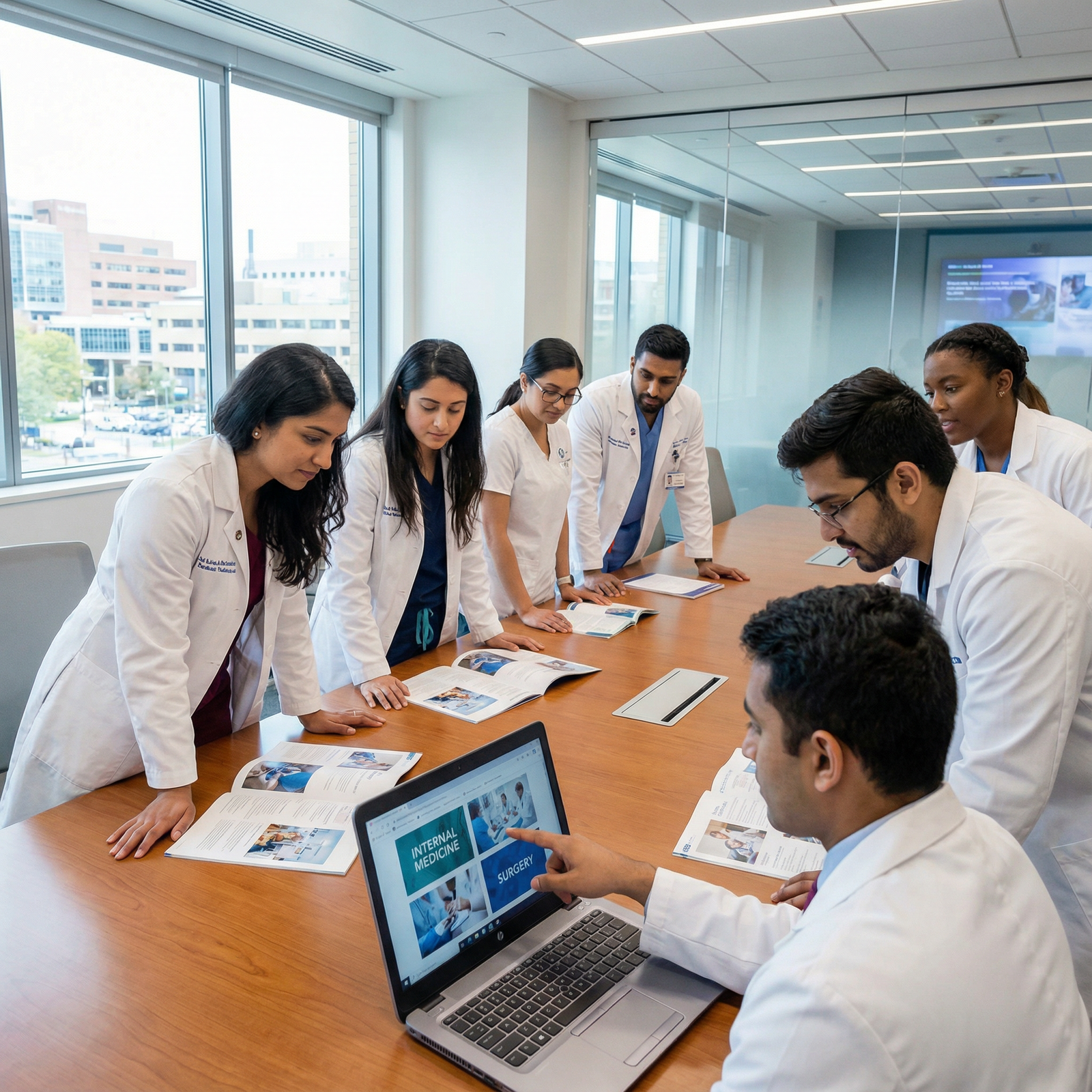Exploring Subsidiary Roles: Career Paths Within Medical Specialties

Understanding Subsidiary Roles: Mapping the Different Paths Within a Medical Specialty
Choosing a medical specialty is one of the most visible decisions in your career path—but it is only the beginning. Within every specialty, there are multiple subsidiary roles and niche focuses that can shape your day-to-day work, schedule, income, and long‑term satisfaction.
For many medical students and residents, the nuance of these subsidiary roles only becomes clear late in training, sometimes after major decisions (like specialty selection) have already been made. Developing an early understanding of these options can help you plan more intentionally, explore the right experiences, and avoid feeling “boxed in” by a broad specialty label.
This guide explores:
- What subsidiary roles are and why they matter
- How they appear in common medical specialties
- Factors that should influence which role you choose
- Practical strategies for exploring options during medical school and residency
- Frequently asked questions about planning your future within a specialty
Throughout, the focus is on physician guidance that is realistic, specific, and grounded in the current landscape of medical education and practice.
What Are Subsidiary Roles Within a Specialty?
In the context of medical specialties, “subsidiary roles” refers to the distinct practice patterns, subspecialties, and job types that exist under the umbrella of one specialty.
For example, “Internal Medicine” is a broad specialty. Under that umbrella, you might find:
- Outpatient internists in community clinics
- Hospitalists managing inpatients
- Cardiologists, nephrologists, or gastroenterologists
- Academic clinician-educators
- Physician–scientists running research programs
Each of these involves different:
- Training pathways (general vs. fellowship)
- Work environments (hospital, clinic, academic center, rural practice)
- Patient populations
- Schedules and lifestyle demands
- Compensation structures
Understanding this internal diversity helps you move beyond the question, “What specialty?” and towards a more powerful one:
“Within this specialty, what type of physician do I want to be?”
This mindset gives you more flexibility and control over your evolving career path.
The Anatomy of a Specialty: Common Subsidiary Roles in Major Fields
The following sections explore how subsidiary roles show up in several major medical specialties. These examples are not exhaustive but illustrate how the same foundational training can lead to very different careers.

Family Medicine: The Archetype of Broad, Flexible Careers
Role Overview
Family medicine is among the broadest medical specialties, providing comprehensive care to patients of all ages, from newborns to older adults. Family physicians often serve as the entry point into the healthcare system and maintain long-term therapeutic relationships with patients and families.
Because of its breadth and flexibility, family medicine offers a wide array of subsidiary roles that can be tailored to your interests.
Key Subsidiary Roles in Family Medicine
General Family Physician (Outpatient-Heavy Practice)
- Core responsibilities: Preventive care, chronic disease management, acute visits, minor procedures.
- Settings: Community clinics, private practice, FQHCs (Federally Qualified Health Centers), academic continuity clinics.
- Lifestyle: Often more predictable hours; call responsibilities vary by practice.
Geriatrician
- Focus: Older adults, multimorbidity, polypharmacy, cognitive decline, functional status, and goals-of-care discussions.
- Training: Family medicine residency + Geriatrics fellowship (typically 1 year).
- Settings: Outpatient geriatrics clinics, skilled nursing facilities, home-based primary care, hospital consult services.
- Career path considerations: High demand with aging populations; rewarding for those who value complex decision-making and longitudinal relationships.
Pediatric-Focused Family Practitioner
- Not formally a subspecialty, but a practice focus.
- Focus: Children and adolescents, vaccinations, developmental surveillance, behavioral concerns.
- Settings: Family medicine clinics with large pediatric panels, school-based health centers, rural practices where family docs manage pediatric care.
- Benefit: Ability to see entire families, addressing parenting and family dynamics alongside pediatric issues.
Sports Medicine Physician
- Training: Family medicine residency + Sports Medicine fellowship.
- Focus: Non-surgical musculoskeletal care, concussion management, exercise prescription, team coverage.
- Roles: Team physician for schools or professional teams, sports clinics, primary care practices with sports focus.
Obstetric-Focused Family Physician
- Focus: Prenatal care, deliveries, postpartum care, also managing newborns.
- Settings: Rural or underserved areas where family physicians provide full-spectrum care including obstetrics.
- Requires: Additional training and comfort with procedures and call.
Family medicine’s subsidiary roles span clinical practice, public health, academic medicine, and leadership (e.g., medical director or program director roles). For students who value flexibility and breadth, this specialty can accommodate a wide range of evolving interests.
Internal Medicine: From Generalist to Highly Specialized
Role Overview
Internal medicine centers on the prevention, diagnosis, and treatment of diseases in adults. It is a foundation for many subspecialties and often serves as a gateway to academic, research, or hospital-based careers.
Key Subsidiary Roles in Internal Medicine
General Outpatient Internist (Primary Care Physician)
- Focus: Chronic disease management (e.g., diabetes, hypertension), preventive care, coordination of specialty referrals.
- Settings: Primary care clinics, multispecialty groups, academic general internal medicine practices.
- Lifestyle: Clinic-based schedule with some call; significant continuity of care.
Hospitalist
- Focus: Inpatient care—admissions, medical management of hospitalized patients, coordination with consultants, discharge planning.
- Settings: Community hospitals, tertiary academic centers, specialized hospitalist services (e.g., oncology hospitalists).
- Schedule: Shift-based (e.g., 7-on/7-off, nocturnist roles), which can offer concentrated work time and extended stretches off.
- Career path: Rapidly growing; many hospitalists take on leadership, quality-improvement, or administrative roles.
Subspecialist (e.g., Cardiologist, Gastroenterologist, Pulmonologist)
- Training: Internal medicine residency + 2–3 years of fellowship (longer for some advanced subspecialties like interventional cardiology).
- Focus: Organ systems or disease categories (e.g., nephrology, infectious disease, rheumatology, hematology/oncology).
- Lifestyle and income: Highly variable by subspecialty; procedure-heavy fields differ from primarily cognitive specialties.
- Example: A nephrologist might manage CKD and dialysis units; a pulmonologist may split time between clinic, ICU, and procedures such as bronchoscopies.
Ambulatory Care Physician with Niche Focus
- Examples: Women’s health, HIV primary care, complex chronic care, lifestyle medicine.
- Often built within general internal medicine roles or academic settings.
- Can cross over into research, quality-improvement, population health, or administrative leadership.
Surgery: Diverse Paths Within an Operative Specialty
Role Overview
Surgery encompasses procedures to treat disease, injuries, and structural abnormalities. It’s often viewed as a monolithic field, but in reality, surgery is composed of numerous distinct careers with different patient populations and technical demands.
Key Subsidiary Roles in Surgery
General Surgeon
- Scope: Abdominal surgery, hernias, gallbladders, breast surgery, soft tissue masses, emergency surgeries (e.g., appendectomy).
- Settings: Community hospitals, critical access hospitals, larger centers with sub-focus areas.
- Role variations: Some general surgeons emphasize trauma, acute care surgery, or colorectal procedures even without formal additional fellowship.
Surgical Subspecialist
- Training: General surgery residency + fellowship (usually 1–3 years) OR direct-entry subspecialties (e.g., neurosurgery, orthopedic surgery).
- Examples:
- Trauma/critical care
- Vascular surgery
- Surgical oncology
- Colorectal surgery
- Plastic and reconstructive surgery
- Orthopedic surgery and subspecialties (sports, spine, hand)
- Trade-offs: Extended training time but often more defined practice focus and procedure set.
Pediatric Surgeon
- Training: General surgery residency + Pediatric Surgery fellowship.
- Focus: Neonatal and pediatric surgical conditions (e.g., congenital anomalies, pediatric tumors, pediatric trauma).
- Challenges: High acuity, delicate anatomy, emotionally intense family interactions.
- Rewards: Deep impact on child and family quality of life; rare but highly specialized role.
Surgeon–Educator or Surgeon–Scientist
- Often based in academic centers.
- Time split between operative practice, teaching residents/medical students, and research (e.g., surgical outcomes, innovation in techniques, basic science).
- Career paths may involve leadership roles such as residency program director, department chair, or division chief.
For students considering surgery, it’s critical to recognize that the subsidiary roles differ drastically in operative intensity, call burden, and lifestyle. Early exposure to multiple surgical practices can clarify preferences.
Psychiatry: Multiple Ways to Focus on Mental Health
Role Overview
Psychiatry specializes in the diagnosis, treatment, and prevention of mental health and substance use disorders. It offers a spectrum of careers ranging from psychotherapy-heavy outpatient practice to highly specialized forensic roles.
Key Subsidiary Roles in Psychiatry
General Adult Psychiatrist
- Settings: Outpatient clinics, inpatient units, partial hospitalization programs, telepsychiatry.
- Focus: Mood disorders, anxiety disorders, psychotic disorders, personality disorders, etc.
- Style: Mix of pharmacologic management and varying degrees of psychotherapy depending on practice.
Child and Adolescent Psychiatrist
- Training: General psychiatry residency + Child and Adolescent Psychiatry fellowship.
- Focus: Developmental considerations, school and family dynamics, neurodevelopmental disorders (e.g., ADHD, autism spectrum).
- Settings: Outpatient clinics, school-based services, pediatric hospitals.
- Ideal for: Those who enjoy working closely with families, schools, and multidisciplinary teams.
Forensic Psychiatrist
- Training: Fellowship in Forensic Psychiatry.
- Focus: Interface of psychiatry and the legal system—competency evaluations, risk assessments, expert testimony, correctional mental health.
- Practice mix: Some combine clinical practice with legal consulting and court work.
Addiction Psychiatrist
- Training: Addiction Psychiatry fellowship.
- Focus: Substance use disorders, medication-assisted treatment (e.g., buprenorphine, methadone), dual diagnosis (co-occurring mental health and substance use).
- Settings: Outpatient, inpatient detox/rehab, community programs, academic centers.
- Growing need: High demand due to the ongoing substance use and overdose crises.
Psychiatry also offers roles in consultation-liaison psychiatry, emergency psychiatry, reproductive psychiatry, and integrated behavioral health—each representing a specific niche within the broader specialty.
Emergency Medicine: Acute Care with Specialized Focus Areas
Role Overview
Emergency medicine (EM) physicians manage acute illnesses and injuries in high-stakes, rapidly changing environments. Under this specialty, you’ll find distinct subsidiary roles tailored to specific populations, settings, or hazards.
Key Subsidiary Roles in Emergency Medicine
General Emergency Physician
- Settings: Academic emergency departments, community EDs, freestanding emergency centers, urgent care centers.
- Focus: Broad case mix—trauma, cardiac events, infections, psychiatric crises, pediatric emergencies.
- Schedule: Shift-based; potential for night shifts, weekends, and holidays.
Toxicologist
- Training: Medical Toxicology fellowship.
- Focus: Poisonings, overdoses, envenomations, environmental and occupational exposures.
- Roles: Consult services in EDs and ICUs, poison control centers, public health agencies, research.
Pediatric Emergency Medicine Physician
- Training: Emergency medicine or pediatrics residency + Pediatric Emergency Medicine fellowship.
- Focus: Acute illnesses and injuries in children; developmental and family-centered care.
- Settings: Children’s hospitals, pediatric EDs in large academic centers.
Disaster Medicine Specialist
- Pathways: Fellowship in Disaster Medicine or acquired expertise through military service, public health, or EM with disaster focus.
- Focus: Mass casualty events, natural disasters, pandemics, systems-level preparedness and response.
- Roles: Hospital disaster planning, governmental agencies, NGOs, international aid work.
Emergency medicine also lends itself to event medicine (stadiums, concerts), aeromedical transport, telemedicine, and administrative leadership roles in ED operations and quality improvement.
Key Factors Influencing Your Choice of Subsidiary Role
Once you’ve narrowed your broad medical specialty, the next step is to understand which subsidiary role best fits your interests and values. Several factors should guide this decision.
1. Personal Interests, Strengths, and Values
Ask yourself:
- Do you prefer acute, high-intensity situations (e.g., EM, trauma surgery) or longitudinal relationships (e.g., family medicine, outpatient psychiatry)?
- Are you drawn more to procedures (e.g., interventional cardiology, GI, orthopedic surgery) or cognitive, diagnostic puzzles (e.g., rheumatology, endocrinology)?
- Do you thrive in structured, protocol-driven environments or in flexible, relationship-based practice?
Examples:
- If you love complex physiology and can handle fast-paced decision-making, you might lean toward ICU, trauma, or toxicology.
- If you value continuity and watching patients grow or age over time, geriatrics, family medicine, or child psychiatry may be more satisfying.
2. Training Length and Educational Pathway
Different subsidiary roles require varying levels of postgraduate training:
- General internal medicine or family medicine: 3 years
- Many subspecialties: 3 years residency + 2–3 years fellowship
- Highly specialized surgery: 5–7+ years residency + fellowship
Consider:
- Your tolerance for prolonged training and delayed attending-level income
- Visa or geographical constraints
- Whether you enjoy academic environments and structured learning for longer periods
3. Work–Life Balance and Lifestyle
Subsidiary roles vary widely in:
- Call schedules (home call vs. in-house)
- Night and weekend responsibilities
- Flexibility for part-time or non-traditional schedules
- Emotional and cognitive load
Examples:
- Hospitalist and EM roles may offer clear shift structures but include nights and weekends.
- Many outpatient primary care roles have more regular hours but may include extensive paperwork and inbox management.
- Surgical subspecialties can be highly rewarding but are often demanding in call, OR time, and emergencies.
Being realistic about your desired lifestyle—and revisiting it as priorities change—is essential.
4. Job Market, Demand, and Geographic Flexibility
The job market for certain roles can vary dramatically:
- Primary care and generalist roles (family medicine, general internal medicine, hospitalist) are often in high demand, especially in rural and underserved areas.
- Some highly competitive subspecialties cluster in urban academic centers, limiting geographic flexibility.
- Emerging or niche fields (e.g., addiction psychiatry, palliative care, telemedicine roles) may be expanding with evolving healthcare needs.
Before committing to a specific fellowship:
- Review job postings in regions where you might want to live.
- Speak with recent graduates about their job search experiences.
- Consider whether you prioritize location or role more highly.
5. Preferred Patient Population and Clinical Setting
Reflect on what types of patients and settings energize you:
- Children vs. adults vs. older adults
- Ambulatory clinics vs. inpatient floors vs. ICU vs. operating room
- Urban academic hospitals vs. community or rural settings
- Individual patient care vs. population-level impact
Your choice of subsidiary role will strongly shape these daily realities. A clear picture of your preferred environment is crucial for a satisfying career path.
6. Mentorship, Role Models, and Physician Guidance
Mentors often influence your perception of what is possible within a specialty. Seek:
- Multiple perspectives within the same specialty (e.g., an outpatient internist, a hospitalist, and a cardiologist)
- Physicians at different career stages
- People whose lifestyles and values align with yours, not just those who are technically excellent
Practical steps:
- Join specialty interest groups and attend lunch talks or panel discussions.
- Ask to shadow in different clinical environments (clinic, OR, ED, ICU).
- During rotations, deliberately ask attendings and residents about their path—what they love, what they would change, and how they chose their specific subsidiary role.

How to Explore Subsidiary Roles During Medical School and Residency
You don’t need to have your entire career scripted out in M1. However, being strategic with your experiences can dramatically improve your understanding of the subsidiary roles available.
During Pre-Clinical Years
- Attend specialty interest group meetings and panel discussions.
- Participate in shadowing—not just “medicine” broadly, but different types of practice within the same specialty.
- Start an Excel or note file where you log impressions: what you liked, disliked, and want to revisit.
During Clinical Rotations
- When on a rotation, ask explicitly about the diversity within that specialty:
- “What are the main types of careers people go into from this residency?”
- “How does your job differ from others with the same training?”
- Seek elective time in settings that show different sides of the field:
- Outpatient vs. inpatient
- Community vs. academic
- Generalist vs. subspecialty clinic
- Pay attention not only to the medicine but to:
- Team dynamics and culture
- How attendings feel about their schedules and lives
- Burnout or satisfaction signals
During Residency
If you already know your broad specialty:
- Use elective time to explore fellowships and niche roles.
- Get involved in research or QI projects in areas you might want to pursue.
- Ask faculty mentors what they see as emerging opportunities in the field—this is especially important given the rapidly changing healthcare environment.
Above all, remain open to the idea that your ideal role may evolve. The goal is not to “lock in” one identity but to understand your options and how to position yourself for them.
Frequently Asked Questions About Subsidiary Roles and Career Paths
1. Are some specialties better than others for keeping my options open?
Yes. Broad medical specialties like internal medicine, pediatrics, and family medicine provide more structured fellowship routes into subspecialties and niche roles. Emergency medicine and psychiatry also offer multiple fellowships and evolving practice models. Surgical specialties can be more specific from the start, but general surgery offers a wide array of subspecialty fellowships.
If you are highly uncertain, starting with a broad specialty that has multiple subsidiary roles and clear fellowship pathways may offer more flexibility.
2. Can I change my subsidiary role later in my career?
In many cases, yes—with some caveats:
- Switching within the same specialty (e.g., from general internal medicine to hospitalist, or from outpatient psychiatry to inpatient) is usually feasible without additional formal training.
- Moving into a fellowship-requiring subspecialty later may be harder depending on years since residency, but not impossible.
- Some shifts (e.g., from a non-procedural specialty into a heavily procedural subspecialty) may be less practical.
Many physicians naturally evolve their careers over time—adding administrative roles, teaching, telehealth, or public health work as interests change.
3. How early do I need to decide on a subspecialty or niche role?
Timelines vary:
- For competitive fellowships (e.g., some surgical subspecialties, certain internal medicine fellowships), you’ll want to start planning early in residency to build research, letters, and focused experiences.
- For many less competitive or newer fields, a decision later in residency can still be successful.
- For generalist roles, you often don’t need to decide until near the end of residency.
During medical school, it’s generally sufficient to understand the landscape and which specialties keep options open, rather than choosing a specific fellowship.
4. How do I balance passion, lifestyle, and financial considerations?
There is no single “right” formula, but consider:
- Passion and interest: Essential for engagement and resilience, especially in demanding fields.
- Lifestyle: Crucial for long-term sustainability; burnout often arises when there is a mismatch between expectations and reality.
- Financial factors: Important, but differences between specialties can be moderated by factors like geographic choice, practice setting, and work hours.
Try to identify roles where at least two of these three areas (interest, lifestyle, compensation) align reasonably well. Talk candidly with attendings about their experiences rather than relying on stereotypes or online forums alone.
5. What is the most practical way to find a mentor in a specific subsidiary role?
- Start with faculty in your medical school or residency program who practice in that area.
- Ask your clerkship director or program leadership to connect you with alumni working in your field of interest.
- Join national specialty organizations; many have student or resident sections with formal mentorship programs.
- When you meet a physician whose career you admire, be direct:
- “I’m really interested in your type of work. Would you be open to a brief meeting or call so I can learn more about your career path?”
Most physicians are willing to offer physician guidance when approached respectfully and with specific questions.
By recognizing that each specialty houses a variety of subsidiary roles, you can think beyond labels like “surgeon” or “internist” and instead design a nuanced, fulfilling career path that reflects your unique strengths, preferences, and aspirations within medicine.

SmartPick - Residency Selection Made Smarter
Take the guesswork out of residency applications with data-driven precision.
Finding the right residency programs is challenging, but SmartPick makes it effortless. Our AI-driven algorithm analyzes your profile, scores, and preferences to curate the best programs for you. No more wasted applications—get a personalized, optimized list that maximizes your chances of matching. Make every choice count with SmartPick!
* 100% free to try. No credit card or account creation required.













